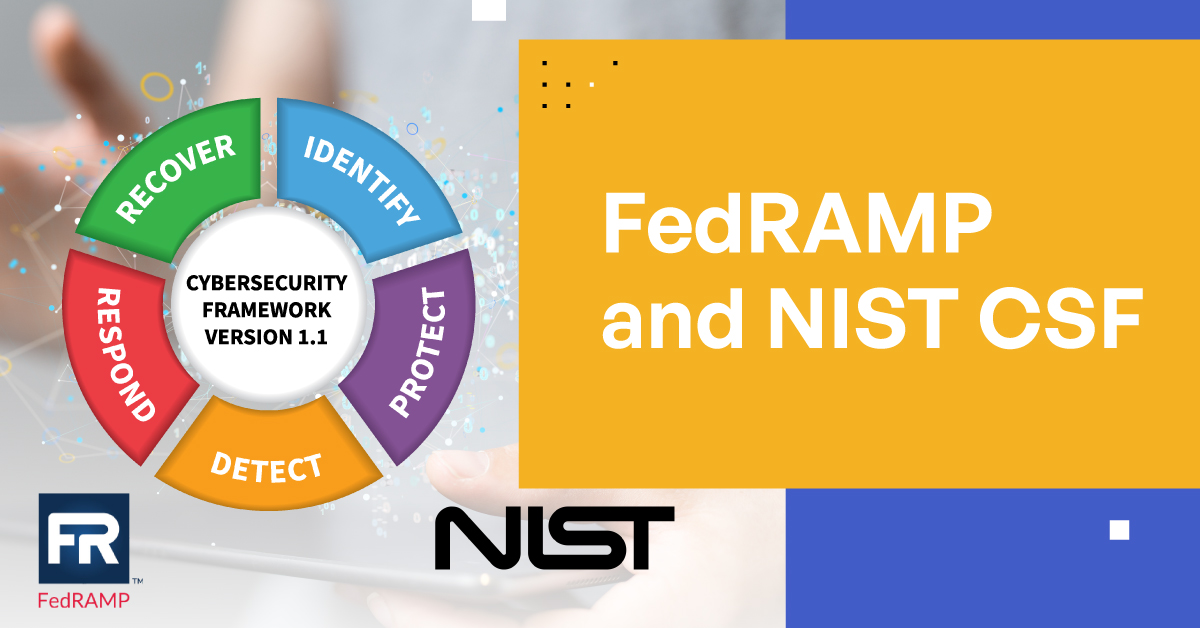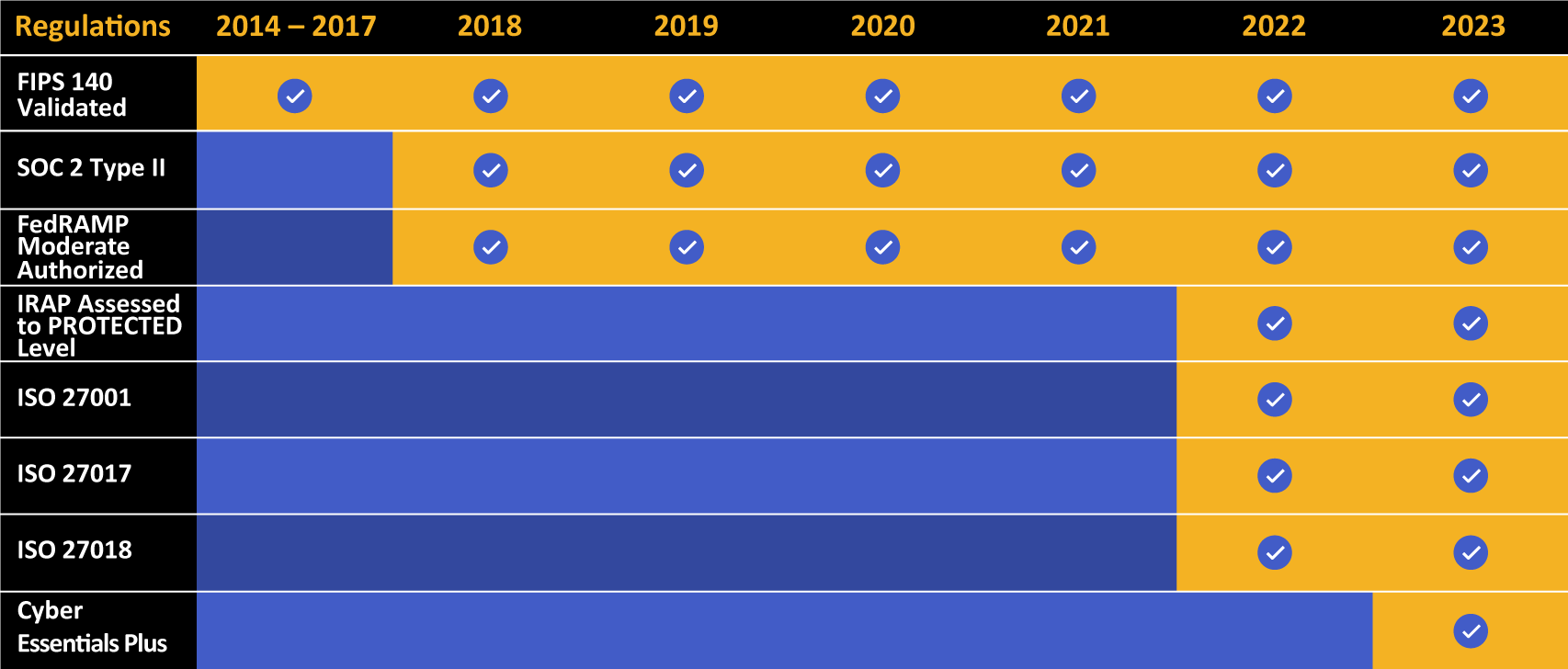FedRAMP and NIST CSF
Organizations rely heavily on cloud services to share, receive, store, process, and manage data in today’s digital landscape. Ensuring that cloud infrastructure is secure is of paramount importance. Two major frameworks for cloud security are the Federal Risk and Authorization Management Program (FedRAMP) and the National Institute of Standards and Technology (NIST) Cybersecurity Framework (CSF). This article will provide an in-depth analysis of these two frameworks, their differences and similarities, and how they can work together to improve cloud security.

Understanding FedRAMP
FedRAMP is a U.S. government-wide program designed to provide a standardized approach to security assessment, authorization, and continuous monitoring for cloud products and services. It was established to ensure that cloud services used by federal agencies meet stringent security requirements, reducing the risks associated with data breaches and other cyber threats.
FedRAMP Benefits for Government Agencies and Cloud Service Providers
The Federal Risk and Authorization Management Program (FedRAMP) offers significant advantages to government agencies and cloud service providers (CSPs) seeking to strengthen their cloud security posture. Here are a few to consider:
Streamlines the Security Assessment Process by Providing a Common Set of Requirements
FedRAMP simplifies the assessment process for government agencies and CSPs by offering a standardized set of security requirements. This standard set of requirements ensures that all parties involved adhere to the same security standards, which promotes consistency and reduces the likelihood of errors or misinterpretations.
Facilitates the Reuse of Assessments, Reducing Costs and Time Spent on Evaluations
One of the critical benefits of FedRAMP is the “do once, use many times” approach to security assessments. This means that once a CSP has undergone the assessment process and achieved authorization, other government agencies can reuse the assessment results, reducing redundant evaluations. As a result, both government agencies and CSPs can save time and resources.
Promotes the Adoption of Secure Cloud Services Across Federal Agencies
FedRAMP encourages federal agencies to adopt secure cloud services by providing a clear and consistent framework for evaluating and selecting CSPs. This helps agencies ensure the security of their data and systems and fosters the growth of a competitive market for secure cloud services.
Enhances Transparency Between CSPs and Federal Agencies
Transparency is a crucial aspect of the FedRAMP program, as it allows government agencies to better understand the security measures CSPs implement. FedRAMP’s standardized security requirements and assessment process create an environment of trust and confidence between government agencies and CSPs, ultimately resulting in more informed decision-making and more robust security practices.

Kiteworks touts a long list of compliance and certification achievements.
Understanding NIST CSF
The NIST CSF is a voluntary framework designed to help organizations manage and reduce cybersecurity risk. It was developed in response to Executive Order 13636, “Improving Critical Infrastructure Cybersecurity,” which called for standards, guidelines, and best practices to help organizations address cybersecurity risks.
NIST CSF Advantages for Enhancing Cybersecurity Posture
The National Institute of Standards and Technology Cybersecurity Framework (NIST CSF) is vital in helping organizations of all sizes and sectors improve their cybersecurity posture. A few notable advantages include the following;
Provides a Flexible, Risk-based Approach Tailored to Individual Organizations
One of the key benefits of the NIST CSF is its flexibility. The framework offers a risk-based approach that can be customized to suit different organizations’ unique needs and requirements. This adaptability allows organizations to prioritize their cybersecurity efforts based on their risk profile and allocate resources accordingly.
Facilitates Communication and Collaboration Between Different Stakeholders
Effective communication and collaboration are crucial for managing cybersecurity risks. The NIST CSF helps bridge the gap between stakeholders, including IT professionals, management, and external partners, by providing a common language for discussing and addressing cybersecurity challenges. This collaborative approach enables organizations to make informed decisions and respond to threats more effectively.
Supports the Integration of Cybersecurity Risk Management Into Overall Risk Management Processes
The NIST CSF emphasizes integrating cybersecurity risk management into an organization’s overall risk management processes. By aligning cybersecurity efforts with broader risk management initiatives, organizations can ensure they are considering all potential threats and vulnerabilities, not just those related to IT systems and networks.
Encourages Continuous Improvement by Promoting the Identification and Adoption of Best Practices
The NIST CSF is designed to foster continuous improvement in cybersecurity practices. It encourages organizations to regularly assess their security posture, identify gaps or weaknesses, and adopt best practices to address these vulnerabilities. This iterative process helps organizations stay ahead of emerging threats and maintain a strong cybersecurity posture in the face of a constantly evolving threat landscape. By promoting a culture of continuous learning and improvement, the NIST CSF helps organizations stay agile and responsive to the ever-changing cybersecurity landscape.
In summary, the NIST CSF offers numerous advantages for organizations looking to improve their cybersecurity posture. Its flexible, risk-based approach enables organizations to tailor their cybersecurity efforts to their unique needs and requirements. The framework fosters communication and collaboration between different stakeholders, ensuring everyone is on the same page when addressing cybersecurity risks. By integrating cybersecurity risk management into overall risk management processes, organizations can comprehensively understand their risk landscape. Finally, the NIST CSF promotes continuous improvement by encouraging the identification and adoption of best practices, helping organizations maintain a robust security posture in the face of evolving threats.
Comparison Between FedRAMP and NIST CSF
While both FedRAMP and the NIST CSF aim to improve cybersecurity, they serve different purposes and target audiences. FedRAMP focuses on cloud services used by federal agencies, ensuring that these services meet strict security requirements. On the other hand, the NIST CSF is a voluntary framework that organizations of any size and sector can adopt to enhance their overall cybersecurity posture.
How FedRAMP and NIST CSF Work Together
Although FedRAMP and the NIST CSF have different scopes and objectives, they can work together to strengthen an organization’s cloud security. Organizations can create a comprehensive and robust security strategy by leveraging the best practices and guidelines both frameworks provide.
Risk Management
FedRAMP and the NIST CSF emphasize risk management’s importance in ensuring effective cybersecurity. FedRAMP’s security assessment process involves evaluating risks associated with cloud services and ensuring that they meet federal security requirements. The NIST CSF provides a structured approach to risk management by helping organizations identify, assess, and prioritize cybersecurity risks. By integrating these two frameworks, organizations can create a holistic risk management strategy that addresses cloud-specific and general cybersecurity risks.
Threat Intelligence
Both frameworks highlight the need for organizations to stay informed about emerging threats and vulnerabilities. The NIST CSF encourages organizations to use threat intelligence to improve their ability to detect, prevent, and respond to cyber threats. FedRAMP requires CSPs to provide continuous monitoring reports that inform federal agencies about potential security issues. By combining the insights from both frameworks, organizations can develop a more comprehensive understanding of the threat landscape.
Compliance
Organizations subject to regulatory requirements can benefit from the compliance guidance of both FedRAMP and the NIST CSF. FedRAMP ensures that cloud services used by federal agencies meet strict security standards, helping agencies remain compliant with various regulations. The NIST CSF can help organizations align their cybersecurity practices with industry standards and best practices, making demonstrating compliance with relevant laws easier.
Real-world Applications of FedRAMP and NIST CSF
Many organizations have successfully adopted FedRAMP and the NIST CSF to strengthen cloud security. For example, federal agencies have leveraged FedRAMP to ensure the secure use of cloud services for storing, processing, and managing sensitive data. Private sector organizations have utilized the NIST CSF to improve their overall cybersecurity posture and demonstrate compliance with industry regulations.
Challenges in Implementing FedRAMP and NIST CSF
Implementing FedRAMP and the NIST CSF can present challenges for organizations, particularly those with limited resources or expertise in cybersecurity. Some of these challenges include:
- Ensuring that cloud services meet the stringent security requirements of FedRAMP
- Integrating the diverse elements of both frameworks into a coherent security strategy
- Addressing the evolving threat landscape and staying up to date with the latest cybersecurity best practices
Assessing Your Current Security Posture
Before implementing FedRAMP and the NIST CSF, organizations should regularly assess their security posture to identify any gaps or areas that require improvement. This process may involve conducting a risk assessment, reviewing existing security policies and procedures, and evaluating the effectiveness of current security controls.
Developing a Roadmap
Once an organization has assessed its current security posture, it can develop a roadmap for implementing FedRAMP and the NIST CSF. This roadmap should outline the steps needed to achieve compliance, including selecting appropriate security controls, allocating resources, and establishing a timeline for implementation.
Building a Security Team
Successful implementation of FedRAMP and the NIST CSF requires the support of a dedicated security team. This team should consist of individuals with expertise in cybersecurity, including risk management, threat intelligence, and compliance. The security team should work closely with other organizational stakeholders to ensure a smooth and successful implementation.
Kiteworks: FedRAMP Moderate Certified and NIST CSF Compliant
The Kiteworks Private Content Network unifies, tracks, controls, and secures file and email data communications in one platform, consolidating file sharing and collaboration, email, managed file transfer, web forms, and application programming interfaces (APIs). Kiteworks is FedRAMP Authorized for Moderate Level Impact, demonstrating an unwavering commitment by the company to protect sensitive content communications for customers across numerous industries and covered by multiple security and data privacy regulations, including the Health Insurance Portability and Accountability Act (HIPAA), the General Data Protection Regulation (GDPR), the California Consumer Privacy Act (CCPA), the Personal Information Protection and Electronic Documents Act (PIPEDA), and others.
Because Kiteworks is certified for FedRAMP, customers are able to accelerate certification and compliance processes for other security standards such as CMMC 2.0 Level 2, ISO 27001, SOC 2, and others. It also lays a foundation for new compliance regulations, such as the four new data privacy state laws that have gone or will go into effect this year.
Kiteworks’ adherence to the NIST CSF and the NIST Privacy Framework demonstrates the company’s commitment to protecting its customers’ private file and email data communications. Core capabilities Kiteworks provides by integrating NIST CSF include collecting justification for sensitive content, modifying the level of access, blocking access, and allowing entry to be requested.
Asset management compliance is relayed through an audit log that includes full transparency around the assignment of an asset class. Integrated into Kiteworks’ governance tracking and controls, the NIST CSF enables customers to manage sensitive content communication exposure risks in regards to both cybersecurity and regulatory compliance.
For more information on the Kiteworks Private Content Network, its FedRAMP Authorized for Moderate Level Impact certification, and integration of the NIST CSF, schedule a tailored demo today.

